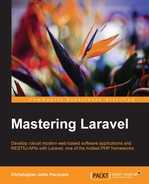If we want to create a form to reserve a room in our accommodation, we can easily call a route from our controller:
/**
* Show the form for creating a new resource.
*
* @return Response
*/
public function create()
{
return view('auth/reserve'),
}Now we need to create a new view that is located at resources/views/auth/reserve.blade.php.
In this view, we can create a form to reserve a room in an accommodation where the user can select the start date, which comprises of the start day of the month and year, and the end date, which also comprises of the start day of the month and year:

The form would begin as before, with a POST to reserve-room. Then, the form label would be placed next to the select input fields. Finally, the day, the month, and the year select form elements would be created as follows:
{!! Form::open(['class'=>'form-horizontal',
'role'=>'form',
'method'=>'POST',
'url'=>'reserve-room']) !!}
{!! Form::label(null, 'Start Date',$labelAttributes) !!}
{!! Form::selectMonth('month',date('m')) !!}
{!! Form::selectRange('date',1,31,date('d')) !!}
{!! Form::selectRange('year',date('Y'),date('Y')+3) !!}
{!! Form::label(null, 'End Date',$labelAttributes) !!}
{!! Form::selectMonth('month',date('m')) !!}
{!! Form::selectRange('date',1,31,date('d')) !!}
{!! Form::selectRange('year',date('Y'),date('Y')+3,date('Y')) !!}
{!! Form::submit('Reserve',
['class'=>'btn btn-primary',
'style'=>'margin-right: 15px;']) !!}
{!! Form::close() !!}Firstly, in the selectMonth method, the first parameter is the name of the input attribute, while the second attribute is the default value. Here, the PHP date method is used to extract the numeric portion of the current month—March in this case:
{!! Form::selectMonth('month',date('m')) !!}
The output, shown here formatted, is as follows:
<select name="month">
<option value="1">January</option>
<option value="2">February</option>
<option value="3" selected="selected">March</option>
<option value="4">April</option>
<option value="5">May</option>
<option value="6">June</option>
<option value="7">July</option>
<option value="8">August</option>
<option value="9">September</option>
<option value="10">October</option>
<option value="11">November</option>
<option value="12">December</option>
</select>A similar technique is applied for the selection of the date, but using the selectRange method, the range of the days in the month are passed to the method. Similarly, the PHP date function is used to send the current date to the method as the fourth parameter:
{!! Form::selectRange('date',1,31,date('d')) !!}Here is the formatted output:
<select name="date">
<option value="1">1</option>
<option value="2">2</option>
<option value="3">3</option>
<option value="4">4</option>
...
<option value="28">28</option>
<option value="29">29</option>
<option value="30" selected="selected">30</option>
<option value="31">31</option>
</select>The date that should be selected is 30, since today is March 30, 2015.
The same technique that is used for the date range is applied for the selection of the year; once again, using the selectRange method. The range of the years is passed to the method. The PHP date function is used to send the current year to the method as the fourth parameter:
{!! Form::selectRange('year',date('Y'),date('Y')+3,date('Y')) !!}Here is the formatted output:
<select name="year">
<option value="2015" selected="selected">2015</option>
<option value="2016">2016</option>
<option value="2017">2017</option>
<option value="2018">2018</option>
</select>Here, the current year that is selected is 2015.
We have the same code that generates our month, date, and year selection form block two times: once for the start date and once for the end date. To refactor the code, we can apply the DRY (don't repeat yourself) principle and create a form macro. This will allow us to avoid calling the form element creation method twice, as follows:
<?php
Form::macro('monthDayYear',function($suffix='')
{
echo Form::selectMonth(($suffix!=='')?'month-'.$suffix:'month',date('m'));
echo Form::selectRange(($suffix!=='')?'date-'.$suffix:'date',1,31,date('d'));
echo Form::selectRange(($suffix!=='')?'year-'.$suffix:'year',date('Y'),date('Y')+3,date('Y'));
});
?>Here, the month, date, and year generation code is placed into a macro, which is inside the PHP tags, and it is necessary to add echo to print out the result. The monthDayYear name is given to this macro method. Calling our macro two times: once after each label; each time adding a different suffix via the $suffix variable. Now, our form code looks like this:
<?php
Form::macro('monthDayYear',function($suffix='')
{
echo Form::selectMonth(($suffix!=='')?'month-'.$suffix:'month',date('m'));
echo Form::selectRange(($suffix!=='')?'date-'.$suffix:'date',1,31,date('d'));
echo Form::selectRange(($suffix!=='')?'year-'.$suffix:'year',date('Y'),date('Y')+3,date('Y'));
});
?>
{!! Form::open(['class'=>'form-horizontal',
'role'=>'form',
'method'=>'POST',
'url'=>'/reserve-room']) !!}
{!! Form::label(null, 'Start Date',$labelAttributes) !!}
{!! Form::monthDayYear('-start') !!}
{!! Form::label(null, 'End Date',$labelAttributes) !!}
{!! Form::monthDayYear('-end') !!}
{!! Form::submit('Reserve',['class'=>'btn btn-primary',
'style'=>'margin-right: 15px;']) !!}
{!! Form::close() !!}